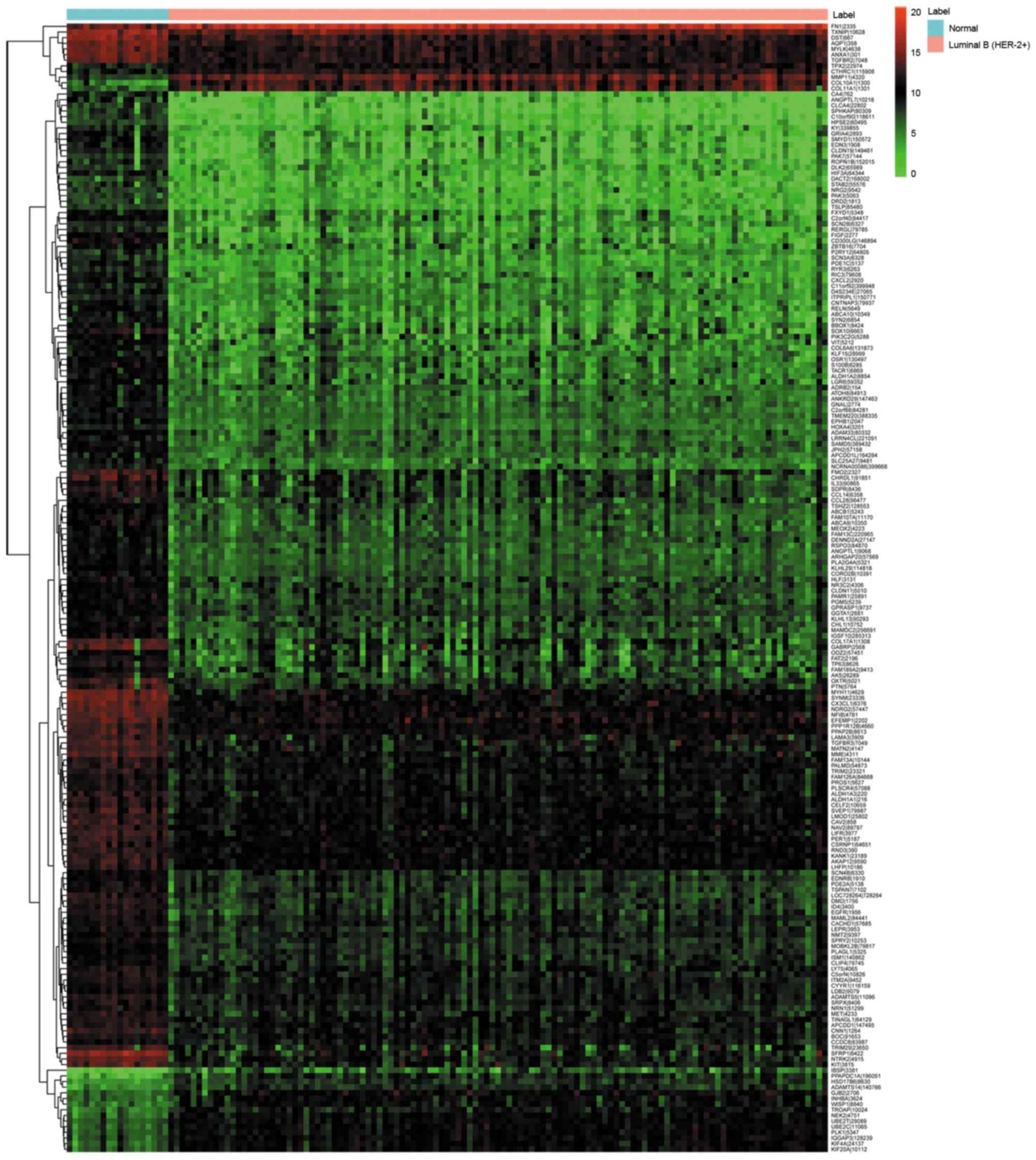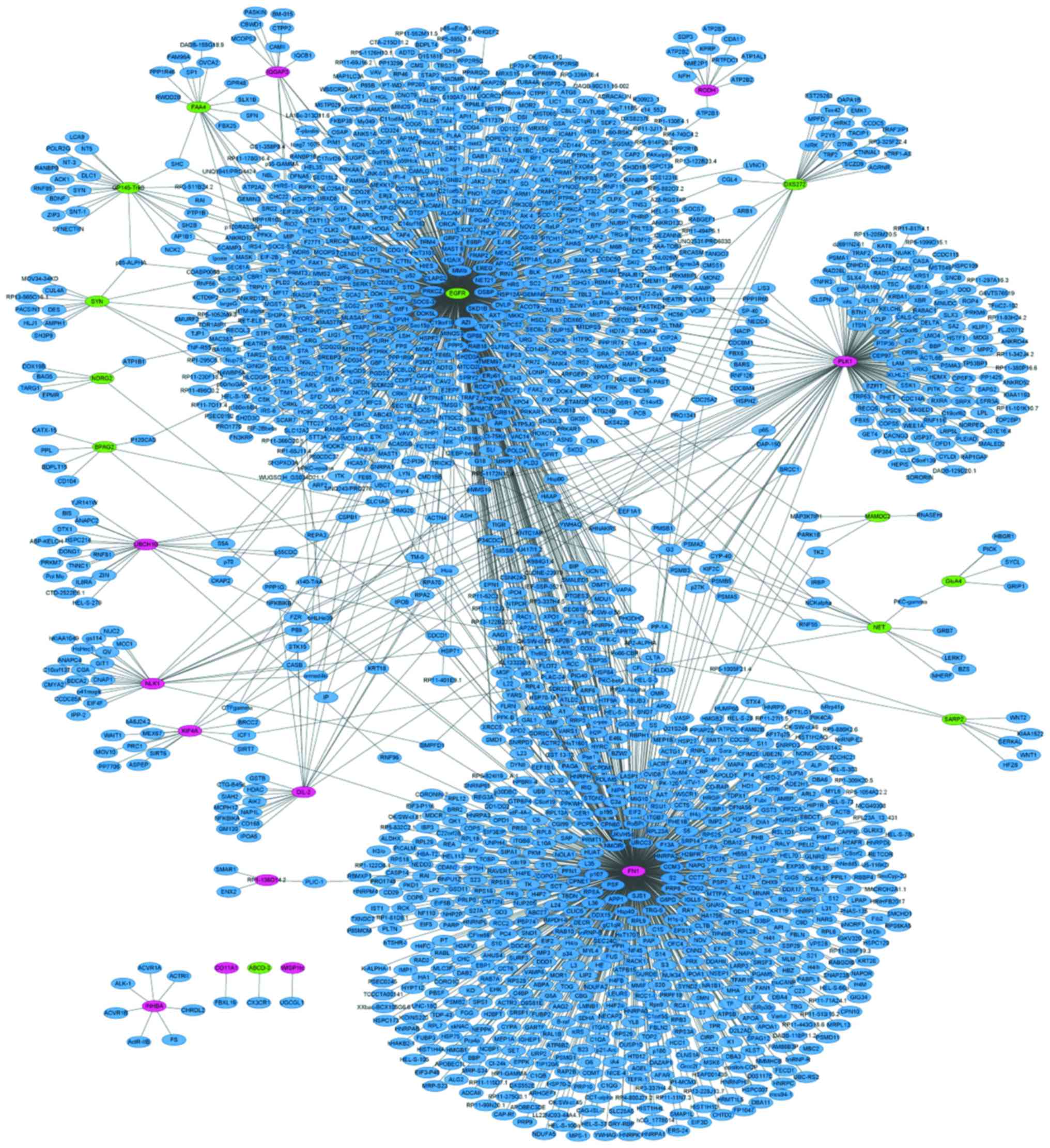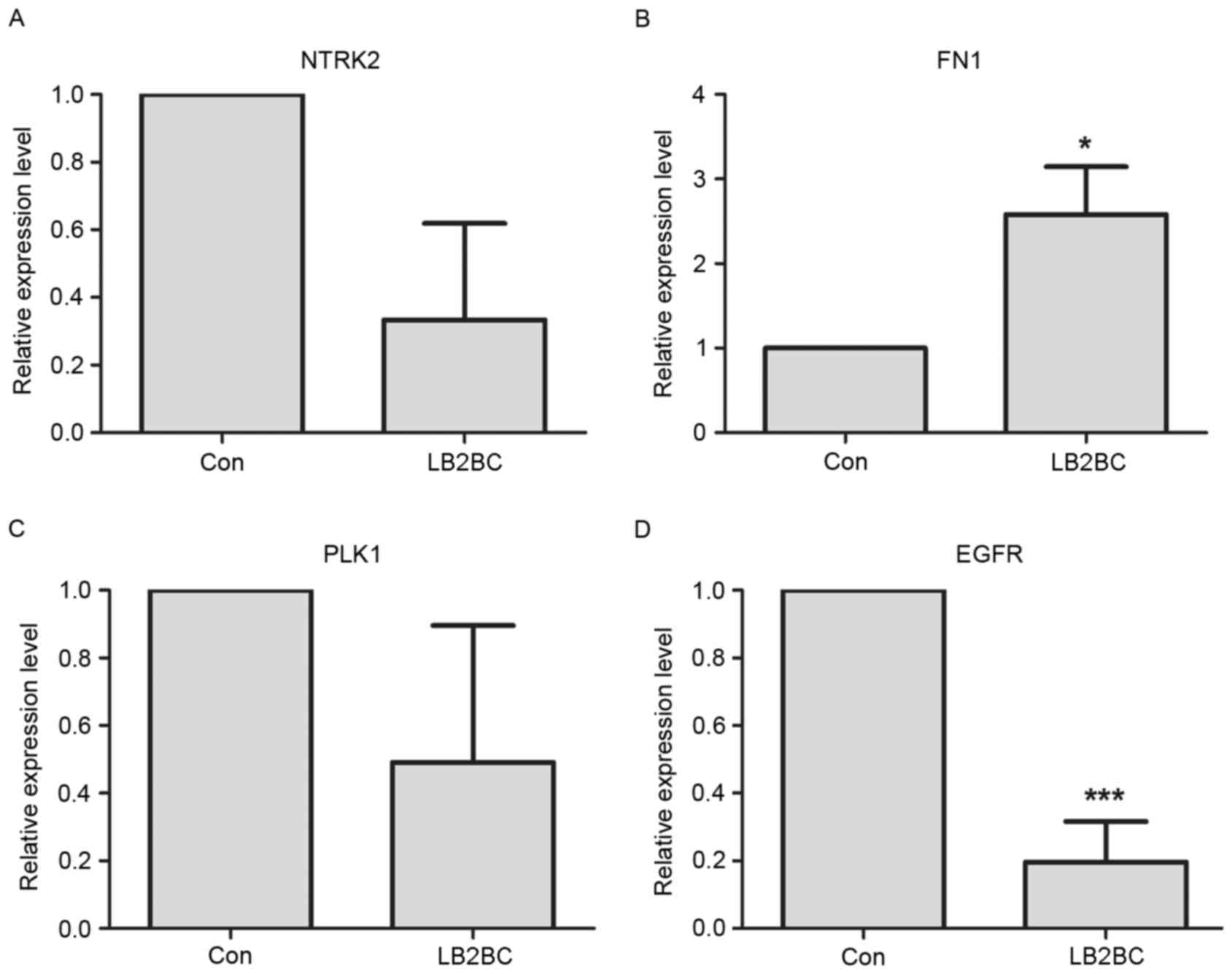|
1
|
Torre LA, Bray F, Siegel RL, Ferlay J,
Lortet-Tieulent J and Jemal A: Global cancer statistics, 2012. CA
Cancer J Clin. 65:87–108. 2015. View Article : Google Scholar : PubMed/NCBI
|
|
2
|
Perou CM, Sørlie T, Eisen MB, van de Rijn
M, Jeffrey SS, Rees CA, Pollack JR, Ross DT, Johnsen H, Akslen LA,
et al: Molecular portraits of human breast tumours. Nature.
406:747–752. 2000. View
Article : Google Scholar : PubMed/NCBI
|
|
3
|
Sørlie T, Perou CM, Tibshirani R, Aas T,
Geisler S, Johnsen H, Hastie T, Eisen MB, van de Rijn M, Jeffrey
SS, et al: Gene expression patterns of breast carcinomas
distinguish tumor subclasses with clinical implications. Proc Natl
Acad Sci USA. 98:pp. 10869–10874. 2001; View Article : Google Scholar : PubMed/NCBI
|
|
4
|
Hu Z, Fan C, Oh DS, Marron JS, He X,
Qaqish BF, Livasy C, Carey LA, Reynolds E, Dressler L, et al: The
molecular portraits of breast tumors are conserved across
microarray platforms. BMC Genomics. 7:962006. View Article : Google Scholar : PubMed/NCBI
|
|
5
|
Dai X, Li T, Bai Z, Yang Y, Liu X, Zhan J
and Shi B: Breast cancer intrinsic subtype classification, clinical
use and future trends. Am J Cancer Res. 5:2929–2943.
2015.PubMed/NCBI
|
|
6
|
Ignatiadis M, Bedard P, Haibe-Kains B,
Haibe-Kains B, Singhal S, Loi S, Criscitiello C, Desmedt C,
Bontempi G, Piccart M, et al: A meta-analysis of gene expression
profiling studies identifies clinically relevant oncogenic pathways
in basal-like breast cancer. Cancer Res. 69:1062009. View Article : Google Scholar
|
|
7
|
Tran B and Bedard PL: Luminal-B breast
cancer and novel therapeutic targets. Breast Cancer Res.
13:2212011. View
Article : Google Scholar : PubMed/NCBI
|
|
8
|
Tomczak K, Czerwińska P and Wiznerowicz M:
The Cancer Genome Atlas (TCGA): An immeasurable source of
knowledge. Contemp Oncol (Pozn). 19:A68–A77. 2015.PubMed/NCBI
|
|
9
|
Anders S and Huber W: Differential
expression analysis for sequence count data. Genome Biol.
11:R1062010. View Article : Google Scholar : PubMed/NCBI
|
|
10
|
Ritchie ME, Phipson B, Wu D, Hu Y, Law CW,
Shi W and Smyth GK: Limma powers differential expression analyses
for RNA-sequencing and microarray studies. Nucleic Acids Res.
43:e472015. View Article : Google Scholar : PubMed/NCBI
|
|
11
|
Eden E, Navon R, Steinfeld I, Lipson D and
Yakhini Z: GOrilla: A tool for discovery and visualization of
enriched GO terms in ranked gene lists. BMC Bioinformatics.
10:482009. View Article : Google Scholar : PubMed/NCBI
|
|
12
|
Kanehisa M: The KEGG database. Novartis
Found Symp. 247:91–103. 119–128. 244–252. 2002. View Article : Google Scholar : PubMed/NCBI
|
|
13
|
Stelzl U, Worm U, Lalowski M, Haenig C,
Brembeck FH, Goehler H, Stroedicke M, Zenkner M, Schoenherr A,
Koeppen S, et al: A human protein-protein interaction network: A
resource for annotating the proteome. Cell. 122:957–968. 2005.
View Article : Google Scholar : PubMed/NCBI
|
|
14
|
Chatr-Aryamontri A, Breitkreutz BJ,
Oughtred R, Boucher L, Heinicke S, Chen D, Stark C, Breitkreutz A,
Kolas N, O'Donnell L, et al: The BioGRID interaction database: 2015
update. Nucleic Acids Res. 39(Database Issue): D470–D478. 2015.
View Article : Google Scholar
|
|
15
|
Chatr-Aryamontri A, Breitkreutz BJ,
Oughtred R, Boucher L, Heinicke S, Chen D, Stark C, Breitkreutz A,
Kolas N, O'Donnell L, et al: The BioGRID interaction database: 2015
update. Nucleic Acids Res. 43(Database Issue): D470–D478. 2015.
View Article : Google Scholar : PubMed/NCBI
|
|
16
|
Shannon P, Markiel A, Ozier O, Baliga NS,
Wang JT, Ramage D, Amin N, Schwikowski B and Ideker T: Cytoscape: A
software environment for integrated models of biomolecular
interaction networks. Genome Res. 13:2498–2504. 2003. View Article : Google Scholar : PubMed/NCBI
|
|
17
|
Schmittgen TD and Livak KJ: Analyzing
real-time PCR data by the comparative C(T) method. Nat Protoc.
3:1101–1108. 2008. View Article : Google Scholar : PubMed/NCBI
|
|
18
|
Li Z, Peng L, Han S, Huang Z, Shi F, Cai
Z, Li X, Zhang P, Zhu H and Jin W: Screening molecular markers in
early breast cancer of the same pathological types but with
different prognoses using Agilent gene chip. Nan Fang Yi Ke Da Xue
Xue Bao. 33:1483–1488. 2013.(In Chinese). PubMed/NCBI
|
|
19
|
Yu X, Liu L, Cai B, He Y and Wan X:
Suppression of anoikis by the neurotrophic receptor TrkB in human
ovarian cancer. Cancer Sci. 99:543–552. 2008. View Article : Google Scholar : PubMed/NCBI
|
|
20
|
Kupferman ME, Jiffar T, El-Naggar A,
Yilmaz T, Zhou G, Xie T, Feng L, Wang J, Holsinger FC, Yu D and
Myers JN: TrkB induces EMT and has a key role in invasion of head
and neck squamous cell carcinoma. Oncogene. 29:2047–2059. 2010.
View Article : Google Scholar : PubMed/NCBI
|
|
21
|
Howe EN, Cochrane DR and Richer JK:
Targets of miR-200c mediate suppression of cell motility and
anoikis resistance. Breast Cancer Res. 13:R452011. View Article : Google Scholar : PubMed/NCBI
|
|
22
|
Chen D, Wang X, Liang D, Gordon J, Mittal
A, Manley N, Degenhardt K and Astrof S: Fibronectin signals through
integrin α5β1 to regulate cardiovascular development in a cell
type-specific manner. Dev Biol. 407:195–210. 2015. View Article : Google Scholar : PubMed/NCBI
|
|
23
|
Steffens S, Schrader AJ, Vetter G, Eggers
H, Blasig H, Becker J, Kuczyk MA and Serth J: Fibronectin 1 protein
expression in clear cell renal cell carcinoma. Oncol Lett.
3:787–790. 2012.PubMed/NCBI
|
|
24
|
Liu X, Ma Y, Yang W, Wu X, Jiang L and
Chen X: Identification of therapeutic targets for breast cancer
using biological informatics methods. Mol Med Rep. 12:1789–1795.
2015. View Article : Google Scholar : PubMed/NCBI
|
|
25
|
Yang X, Jia M, Li Z, Lu S, Qi X, Zhao B,
Wang X, Rong Y, Shi J, Zhang Z, et al: Bioinformatics analysis of
aggressive behavior of breast cancer via an integrated gene
regulatory network. J Cancer Res Ther. 10:1013–1018. 2014.
View Article : Google Scholar : PubMed/NCBI
|
|
26
|
Dorman SN, Baranova K, Knoll JH, Urquhart
BL, Mariani G, Carcangiu ML and Rogan PK: Genomic signatures for
paclitaxel and gemcitabine resistance in breast cancer derived by
machine learning. Mol Oncol. 10:85–100. 2016. View Article : Google Scholar : PubMed/NCBI
|
|
27
|
Morita Y, Hata K, Nakanishi M, Omata T,
Morita N, Yura Y, Nishimura R and Yoneda T: Cellular fibronectin 1
promotes VEGF-C expression, lymphangiogenesis and lymph node
metastasis associated with human oral squamous cell carcinoma. Clin
Exp Metastasis. 32:739–753. 2015. View Article : Google Scholar : PubMed/NCBI
|
|
28
|
Gutteridge RE, Ndiaye MA, Liu X and Ahmad
N: Plk1 inhibitors in cancer therapy: From laboratory to clinics.
Mol Cancer Ther. 15:1427–1435. 2016. View Article : Google Scholar : PubMed/NCBI
|
|
29
|
Maire V, Némati F, Richardson M,
Vincent-Salomon A, Tesson B, Rigaill G, Gravier E, Marty-Prouvost
B, De Koning L, Lang G, et al: Polo-like kinase 1: A potential
therapeutic option in combination with conventional chemotherapy
for the management of patients with triple-negative breast cancer.
Cancer Res. 73:813–823. 2013. View Article : Google Scholar : PubMed/NCBI
|
|
30
|
Ou O, Huppi K, Chakka S, Gehlhaus K,
Dubois W, Patel J, Chen J, Mackiewicz M, Jones TL, Pitt JJ, et al:
Loss-of-function RNAi screens in breast cancer cells identify
AURKB, PLK1, PIK3R1, MAPK12, PRKD2, and PTK6 as sensitizing targets
of rapamycin activity. Cancer Lett. 354:336–347. 2014. View Article : Google Scholar : PubMed/NCBI
|
|
31
|
Serna E, Lopez-Gines C, Monleon D,
Muñoz-Hidalgo L, Callaghan RC, Gil-Benso R, Martinetto H,
Gregori-Romero A, Gonzalez-Darder J and Cerda-Nicolas M:
Correlation between EGFR amplification and the expression of
microRNA-200c in primary glioblastoma multiforme. PLoS One.
9:e1029272014. View Article : Google Scholar : PubMed/NCBI
|
|
32
|
Naruke A, Azuma M, Takeuchi A, Ishido K,
Katada C, Sasaki T, Higuchi K, Tanabe S, Saegusa M and Koizumi W:
Comparison of site-specific gene expression levels in primary
tumors and synchronous lymph node metastases in advanced gastric
cancer. Gastric Cancer. 18:262–270. 2015. View Article : Google Scholar : PubMed/NCBI
|
|
33
|
Yang CH, Chou HC, Fu YN, Yeh CL, Cheng HW,
Chang IC, Liu KJ, Chang GC, Tsai TF, Tsai SF, et al: EGFR
over-expression in non-small cell lung cancers harboring EGFR
mutations is associated with marked down-regulation of CD82.
Biochim Biophys Acta. 1852:1540–1549. 2015. View Article : Google Scholar : PubMed/NCBI
|
|
34
|
Park HS, Jang MH, Kim EJ, Kim HJ, Lee HJ,
Kim YJ, Kim JH, Kang E, Kim SW, Kim IA and Park SY: High EGFR gene
copy number predicts poor outcome in triple-negative breast cancer.
Mod Pathol. 27:1212–1222. 2014. View Article : Google Scholar : PubMed/NCBI
|

















